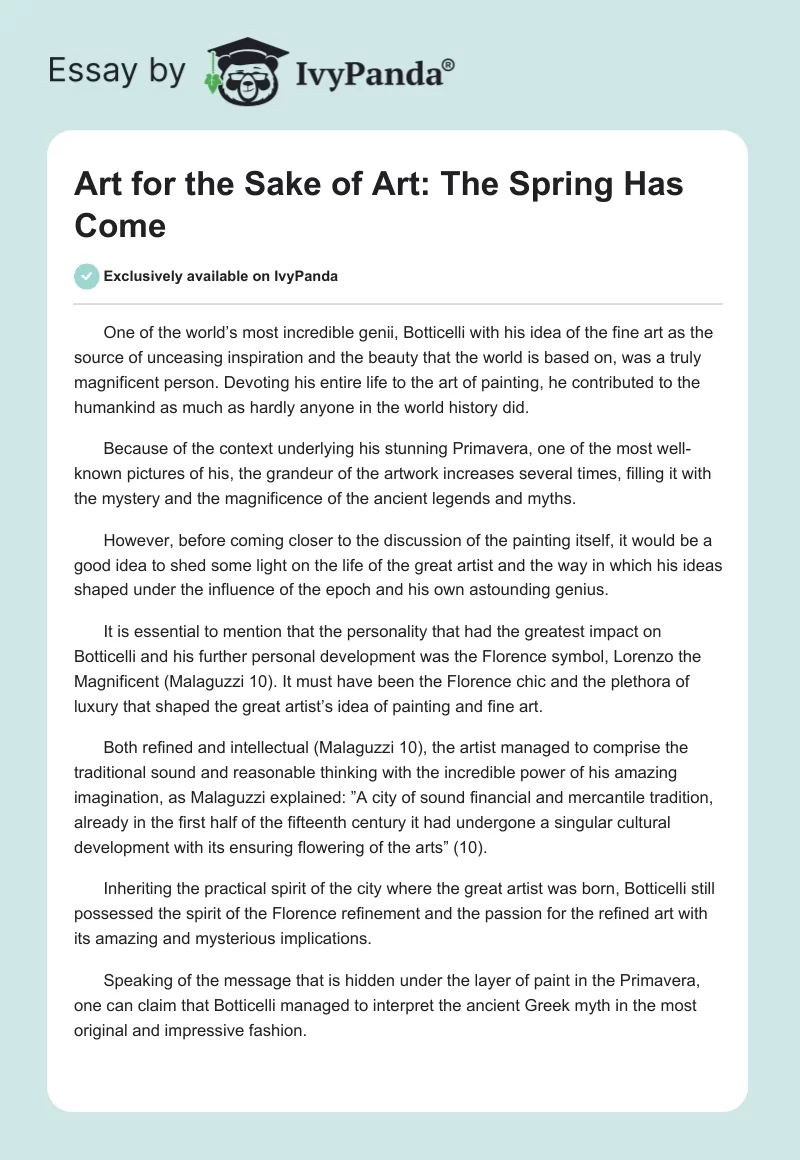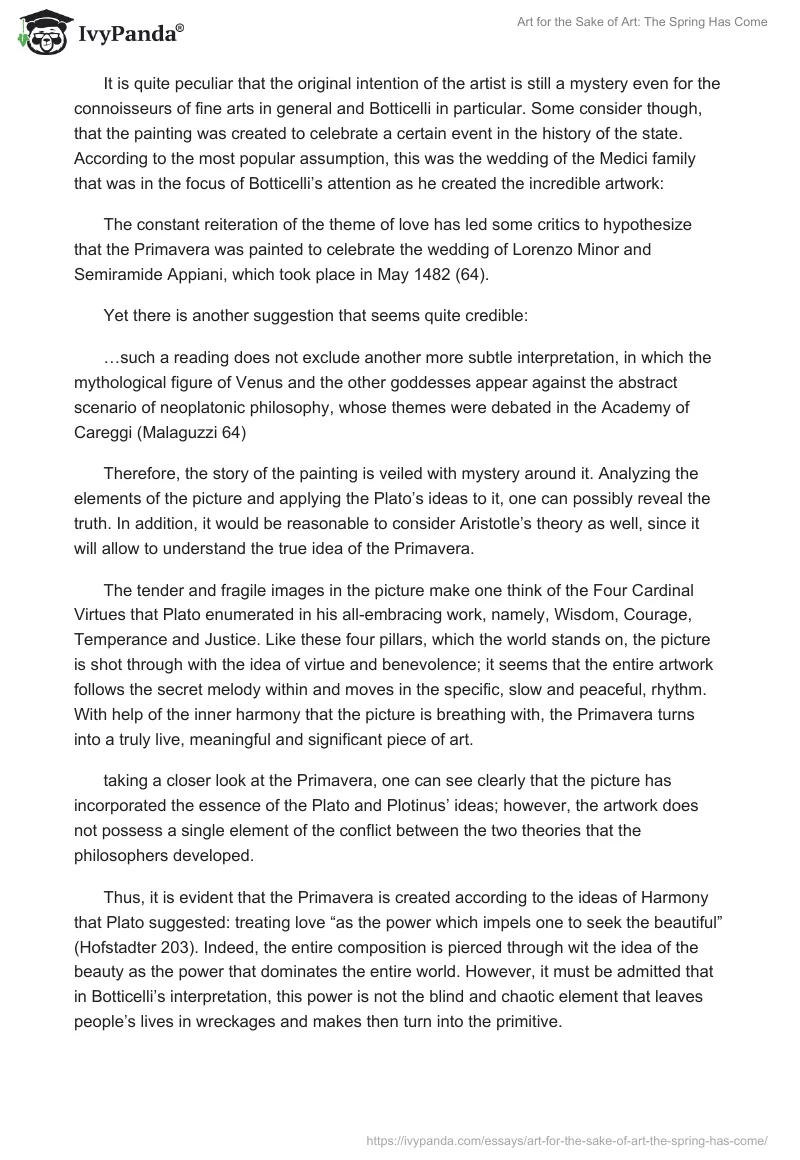One of the world’s most incredible genii, Botticelli with his idea of the fine art as the source of unceasing inspiration and the beauty that the world is based on, was a truly magnificent person. Devoting his entire life to the art of painting, he contributed to the humankind as much as hardly anyone in the world history did.
Because of the context underlying his stunning Primavera, one of the most well-known pictures of his, the grandeur of the artwork increases several times, filling it with the mystery and the magnificence of the ancient legends and myths.
However, before coming closer to the discussion of the painting itself, it would be a good idea to shed some light on the life of the great artist and the way in which his ideas shaped under the influence of the epoch and his own astounding genius.
It is essential to mention that the personality that had the greatest impact on Botticelli and his further personal development was the Florence symbol, Lorenzo the Magnificent (Malaguzzi 10). It must have been the Florence chic and the plethora of luxury that shaped the great artist’s idea of painting and fine art.
Both refined and intellectual (Malaguzzi 10), the artist managed to comprise the traditional sound and reasonable thinking with the incredible power of his amazing imagination, as Malaguzzi explained: ”A city of sound financial and mercantile tradition, already in the first half of the fifteenth century it had undergone a singular cultural development with its ensuring flowering of the arts” (10).
Inheriting the practical spirit of the city where the great artist was born, Botticelli still possessed the spirit of the Florence refinement and the passion for the refined art with its amazing and mysterious implications.
Speaking of the message that is hidden under the layer of paint in the Primavera, one can claim that Botticelli managed to interpret the ancient Greek myth in the most original and impressive fashion.
It is quite peculiar that the original intention of the artist is still a mystery even for the connoisseurs of fine arts in general and Botticelli in particular. Some consider though, that the painting was created to celebrate a certain event in the history of the state. According to the most popular assumption, this was the wedding of the Medici family that was in the focus of Botticelli’s attention as he created the incredible artwork:
The constant reiteration of the theme of love has led some critics to hypothesize that the Primavera was painted to celebrate the wedding of Lorenzo Minor and Semiramide Appiani, which took place in May 1482 (64).
Yet there is another suggestion that seems quite credible:
…such a reading does not exclude another more subtle interpretation, in which the mythological figure of Venus and the other goddesses appear against the abstract scenario of neoplatonic philosophy, whose themes were debated in the Academy of Careggi (Malaguzzi 64)
Therefore, the story of the painting is veiled with mystery around it. Analyzing the elements of the picture and applying the Plato’s ideas to it, one can possibly reveal the truth. In addition, it would be reasonable to consider Aristotle’s theory as well, since it will allow to understand the true idea of the Primavera.
The tender and fragile images in the picture make one think of the Four Cardinal Virtues that Plato enumerated in his all-embracing work, namely, Wisdom, Courage, Temperance and Justice. Like these four pillars, which the world stands on, the picture is shot through with the idea of virtue and benevolence; it seems that the entire artwork follows the secret melody within and moves in the specific, slow and peaceful, rhythm. With help of the inner harmony that the picture is breathing with, the Primavera turns into a truly live, meaningful and significant piece of art.
taking a closer look at the Primavera, one can see clearly that the picture has incorporated the essence of the Plato and Plotinus’ ideas; however, the artwork does not possess a single element of the conflict between the two theories that the philosophers developed.
Thus, it is evident that the Primavera is created according to the ideas of Harmony that Plato suggested: treating love “as the power which impels one to seek the beautiful” (Hofstadter 203). Indeed, the entire composition is pierced through wit the idea of the beauty as the power that dominates the entire world. However, it must be admitted that in Botticelli’s interpretation, this power is not the blind and chaotic element that leaves people’s lives in wreckages and makes then turn into the primitive.
As Hofstadter explained, “[…] it is also an interpretation of Plato through which we can understand the distinctive originality of Italian Humanism which gave a new direction to the understanding and interpretation of art” (203). Thus, Botticelli reveals the new shapes that the ancient ideas can take, in his Primavera.
In accordance with Plotinus’ ideas Botticelli created his picture filed with the most mysterious ideas; yet the key principle, art for the sake of art, remained untouched: “The aim of art is beauty; and beauty itself is the value of harmonious proportion, brought down from the cosmos to art” (Hofstadter 15). Filled with the inner harmony and balance, the Primavera is a perfect specimen of Plato and Platinus’ ideas intertwined together with the stirring genius in a single artwork. As Malaguzzi explained,
For Plato in fact there existed two different kinds of love, impersonated by two similar but different goddesses. One was the so-called vulgar love, impersonated by Venus Pandemia, the generating principle of mankind. The other was divine love, belonging to a higher dimension, impersonated by Venus Urania (64).
In the Primavera, it is clear that the two opposing ideas clash to create the divine harmony. However, these are not only the ideas of Plato and Platinus that the Primavera incorporates. Taking a closer look at the refined lines of the painting and its subtle colors, one can see distinctly that Botticelli also considered the ideas of Aristotle.
Considering the famous Aristotle’s decision, the decision “to analyze change in terms of the actualization of potentiality” (Lear 63), one can claim that the style and the manner of painting reflect the given idea in the most explicit way. The characters in the picture are not stiff, but as if caught in the middle of a motion – it seems that they are about to leave the frame of the picture and step into the reality.
The fluctuation of shapes has been perfectly captured in the painting. Moreover, the picture represents the famous golden mean as the essence of virtue as Aristotle interpreted it: “Every virtue is a mean, or middle ground, between two extremes” (M: 8, S: 9). Using the magnificence and decorum in his painting according to the ideas of Aristotle (M: 8, S: 10), Botticelli creates the artwork that does not depict the beauty, but is the beauty itself.
Offering both an intriguing trip into the past and sufficient food fro thoughts, the Primavera is one of the most mysterious and enchanting work of arts of the century. With help of his genius, Botticelli managed to seize the very idea of Plato, Plotinus and Aristotle’s ideas and at the same time depict beauty as it is, pure and virgin. This is the Primavera – the spring of art, the new era of the humankind. This is Botticelli.
Works Cited
Hofstadter, Albert, and Richard Francis Kuhns. Philosophers of Art and Beauty: Selected Readings in Aesthetics from Plato to Heidegger. Chicago, IL: University of Chicago Press, 1976. Print.
Lear, Jonathan. Aristotle: The Desire to Understand. Cambridge, UK: Cambridge University Press, 1988. Print.
Malaguzzi, Silvia. Botticelli. Firenze, IT: Giunti Editore, 2004. Print.


